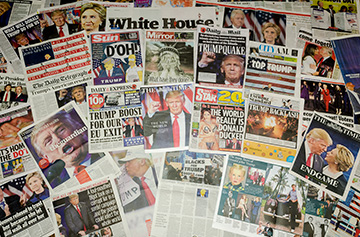
The world press had a wide range of reactions to Donald Trump’s victory in the U.S. presidential election. [Image: iStock] [Enlarge image]
Editor’s note: Coming less than five months after the shakeup wrought by the U.K.’s Brexit vote, the election of Donald J. Trump as the U.S. president—who will assume the office in late January 2017—has dealt a second political shock to the world stage. As with the initial days after Brexit, the situation remains in flux and its meaning is unclear. Nonetheless, it’s natural for OPN’s readers to wonder about the implications for optics and photonics under a Trump presidency.
OSA’s senior industry adviser, Tom Hausken, has provided some initial thoughts on the matter for OSA Industry Development Associates (OIDA). With his permission, we share his main thoughts below.
If there is one word to summarize the post-election outlook, it’s “uncertainty.” There is the uncertainty over priorities and policies at the White House itself, but also over what Congress will do and what legal challenges may be brought through the judicial system. Will there be a massive stimulus and economic growth? A trade war and recession? A new cycle of gridlock and dysfunction? On one thing everyone agrees: this is uncharted territory in modern U.S. politics.
Candidate Trump was most consistent in his positions on U.S. isolationism: immigration, trade and foreign partnerships. The topics of most interest to the optics and photonics industry fall under the category of technology and innovation policy. He has articulated few policy positions in this category, outside of taxes and trade. (The Information Technology & Innovation Foundation offers a summary of the Trump campaign’s positions on technology and innovation policy.)
There are many issues that could impact optics and photonics companies: corporate tax rates, repatriation of profits, R&D funding, H-1B visas for highly-skilled workers, trade agreements and tariffs, “Buy America” policies and penalties for offshore production, deregulation, and much more. While all companies would likely welcome a lower corporate tax rate, many policy changes would favor some companies while hurting others, depending on where they sit in the market.
More than 90 percent of optics and photonics companies are small enterprises, but the large global companies earn more than 80 percent of the revenue. The many small companies may have the most to gain, while the large companies that dominate revenue might see the most disruption. Some policy changes might simultaneously help and hurt companies that move their materials and parts around complex global supply chains, which is becoming more and more of our industry.
Is this like Brexit? This past summer, we wrote about the U.K. Brexit vote, particularly with respect to issues such as European R&D funding, company location, the recruitment of talent, and currency effects. Yet the implications of the Brexit decision—with all of the uncertainties it brings—are more identifiable and more localized to the U.K. and Europe. The Brexit decision is also likely to stay in place for years, even decades, and may weaken the European Union itself.
The implications of the next U.S. presidential term seem greater in scale and scope (or at least for someone watching from inside the U.S. this week), but it is not a dissolution of the federation. There will be a midterm congressional election in two years, and voters will judge the performance of the new president himself two years after that.
The supertanker ship of state called the U.S. federal government doesn’t make sharp turns. Notwithstanding the many executive orders that the new president can sign on his first day in office, countless contracts are already in place, budgets take time to write and pass, and many executive orders and rule changes have to follow specific and careful procedures to become law. Seemingly simple changes in funding and policy have intricate and far-reaching ramifications that will face opposition from diverse and unexpected interest groups.
Just understanding how to unwind policies and programs within the labyrinthine government apparatus takes insider expertise. Whether you think it’s bad or good, there will be substantial inertia and gridlock going forward, some of it by design and some due to the sheer scale of government and its role in everything in the economy.
We tend to overestimate short-term impacts and underestimate long-term impacts. This rule may also apply to the impact of U.S. presidential elections. The shorter-term dividends of a Trump presidency won’t likely be as large as Trump’s supporters hope, nor as dire as Clinton’s supporters fear. And the longer-term consequences are, well, further down the road.
The long-term impact of the 2016 U.S. election will be significant, but the direct impact to the optics and photonics industry will take time to play out. In the meantime, it will be business as usual.
